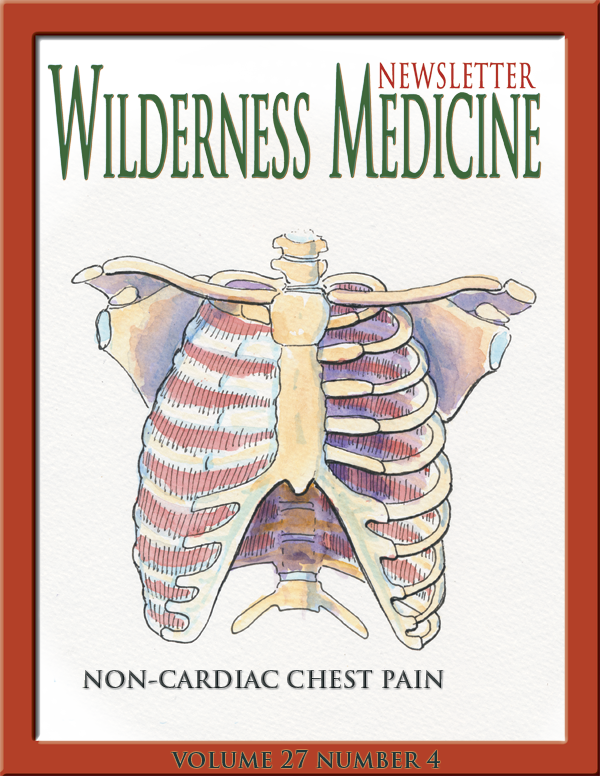NON-CARDIAC CHEST PAIN

ISSN-1059-6518
NON-CARDIAC CHEST PAIN
By Frank Hubbell, DO
Illustrations by T.B.R. Walsh
In the June 2014 edition of the WMNL, the pathophysiology, recognition, and treatment of cardiovascular disease was discussed. With these various illnesses the source of the chest pain is a problem with the coronary circulation of the heart itself. In this issue of the WMNL, we will look at the sources of the non-cardiac chest pain.
Imagine you are working with a group of park rangers in the Rockies when the team gets a call for a hiker in distress. As it turns out, the hiker is reportedly on the same trail as you are, and they are an estimated 3 miles away, about a one-hour hike from you present location. According to dispatch, they were notified via cell phone from the hiking party that one of their members is complaining of chest pain and does not feel as if he can continue on.
Dispatch is able to give you some additional information: the hiker is a 46-year-old male, one of four in their hiking group. The group left the trailhead before sunrise and were taking the most direct route to the summit, in hopes that they would reach the summit before sunset and hike down in the dark with headlamps. They are not prepared to stay out overnight. The other three hikers are all men in their late 20’s. They have known each other for years, as he was their outing club director and their math teacher in high school.
An hour later you catch up with the hiking group. They are sitting together under a large pine tree, sharing some gorp (trail mix) and water. You introduce yourself to the patient and explain that you are a paramedic working with the park rangers. The patient is very glad to see you and seems to be quite relieved.
He states that after hiking for several hours, the incline of the trail became quite steep, and he was having a hard time keeping up with his younger companions. As he pushed onward, he began to develop pain in the anterior of his chest, tingling in his hands and arms, shortness of breath, mild nausea, and began to feel weak, almost as if he was going to pass out. He states that he did recover completely after a five-minute rest, but when he would start hiking uphill again, the symptoms returned after about fifteen minutes. Currently, he feels much better, since they have been at rest for the past hour. He feels that he can walk out, as it is mostly downhill.
The real concern regarding this 46yo male, is whether the chest pain is cardiac or not. If cardiac, he deserves rapid evacuation. If non-cardiac chest pain, then he can most likely walk off the mountain.
You should always err on the side of caution and assume that all chest pain is cardiac until proven otherwise. To sort out cardiac chest pain from non-cardiac chest pain requires a good history, specifically looking for the cardiac risk factors and a good physical exam to try to accurately determine the source of the pain. As you read the descriptions of non-cardiac chest pain types, you will notice that some sources would require immediate evacuation. When in doubt, as stated above, always err on the side of caution and assume all chest pain is cardiac until proven otherwise.
